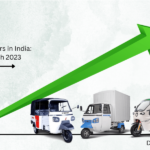
Vehicle-to-Grid Technology: A future solution for peak energy demand
As the world shifts towards sustainable transportation, electric vehicles (EVs) are becoming increasingly prevalent. By 2030, cities like Gurugram are expected to host significant numbers of EVs, transforming urban mobility. However, this surge in electric vehicles presents both challenges and opportunities for power grids.
One innovative solution that stands out is vehicle to grid (V2G) technology, which promises to turn EVs from mere consumers of electricity into vital components of grid stability and reliability.
The concept of vehicle to grid technology
Vehicle-to-Grid technology is a revolutionary system that allows electric vehicles to interact with the power grid, enabling not just charging of the vehicle but also the discharge of energy back into the grid. This bi-directional energy flow offers a plethora of benefits, ranging from enhanced grid stability to improved energy efficiency and even financial rewards for EV owners.
The Gurugram Scenario: A Vision for 2030

Imagine Gurugram in 2030, a city bustling with 100,000 electric cars. With an average battery capacity of 30 kWh per vehicle, these EVs represent a substantial energy reservoir.
During peak evening hours, when the demand for electricity skyrockets, V2G technology can play a crucial role in balancing the grid. Assuming 50% of these vehicles are connected to the grid through V2G at any given moment, and each contributes 1% of its battery capacity, a substantial amount of energy can be mobilized to meet the demand.
With 50,000 EVs participating in the V2G program and each offering 300 Wh (1% of 30 kWh) of their capacity, the total energy contributed back to the grid would be 15,000 kWh or 15 MWh. This energy can be crucial in managing the grid’s load, especially during the evening peak hours, thereby alleviating stress on the grid and reducing the need for peaker plants, which are often more expensive and less environmentally friendly.
Benefits of vehicle to grid in Urban Cities like Gurugram in India
✅ Peak Load Leveling
One of the primary benefits of V2G technology is its ability to level the electricity demand peak. During times of high electricity demand, V2G-enabled vehicles can feed stored electricity back into the grid, reducing the need for additional power generation from conventional sources. This not only helps in managing the peak load but also reduces the stress on the grid infrastructure, potentially leading to lower energy costs for all consumers.
✅ Grid Support
V2G technology provides critical support to the grid by offering a distributed energy resource that can be tapped into as needed. This can be particularly useful in situations where the grid is under stress due to high demand or during emergencies. By aggregating the energy storage capabilities of thousands of electric vehicles, V2G can provide a significant source of power to support grid operations.
✅ Load Shifting
Load shifting is another significant advantage of V2G technology. It allows for the strategic charging and discharging of EV batteries based on grid demand and energy prices. By charging EVs during off-peak hours when electricity is cheaper and demand is lower, and discharging during peak hours, V2G helps to balance the grid load and optimize energy consumption patterns.
✅ Renewable Energy Integration
Integrating renewable energy sources into the grid is a challenge due to their intermittent nature. V2G technology can help mitigate this issue by storing excess renewable energy (e.g., solar or wind power) in EV batteries during periods of high production and low demand. This stored energy can then be released back into the grid when demand is higher, enhancing the utilization of renewable energy sources.
✅ Grid Ancillary Services
V2G technology enables electric vehicles to provide ancillary services to the grid, such as frequency regulation, voltage support, and spinning reserves. These services are essential for maintaining the stability and reliability of the power grid, and V2G technology can provide them in a flexible and cost-effective manner.
✅ Smart Charging and Communication
Smart charging and communication are integral components of V2G technology. They allow for the real-time exchange of information between electric vehicles and the grid operator, enabling dynamic management of charging and discharging processes based on grid needs and energy prices. This capability ensures that EVs are charged in the most efficient way possible, benefiting both the grid and the vehicle owners.
✅ Grid Resilience
Finally, V2G technology enhances grid resilience by providing a decentralized network of energy storage units that can be leveraged in case of grid disturbances or outages. In the event of a power outage, V2G-enabled vehicles can supply emergency power to critical infrastructure and services, improving the overall resilience of the power
As Gurugram and similar cities move towards a future dominated by electric vehicles, V2G technology offers a promising pathway to utilize these assets beyond transportation, contributing to a more stable, efficient, and sustainable energy landscape. Embracing V2G could turn the potential challenge of mass EV adoption into a strategic advantage, showcasing a forward-thinking approach to urban energy management and environmental stewardship.
Looking Forward
The journey towards integrating V2G technology into our urban fabric is complex and multifaceted. It demands innovation, collaboration, and a commitment to sustainability. Yet, the potential rewards—economic, environmental, and societal—are immense. As we envision a future where cities like Gurugram lead in smart, sustainable energy use, the role of V2G technology stands out as a cornerstone in this transformative era of urban mobility and energy management.




